Jamaica is a beautiful Caribbean island that is home to many various species of sharks. The sharks found in Jamaica come in a variety of different sizes and types, which makes it a popular place for shark enthusiasts. Although you may not see any great white sharks here, the warm waters of Jamaica bring in many other species of sharks and diverse marine life.
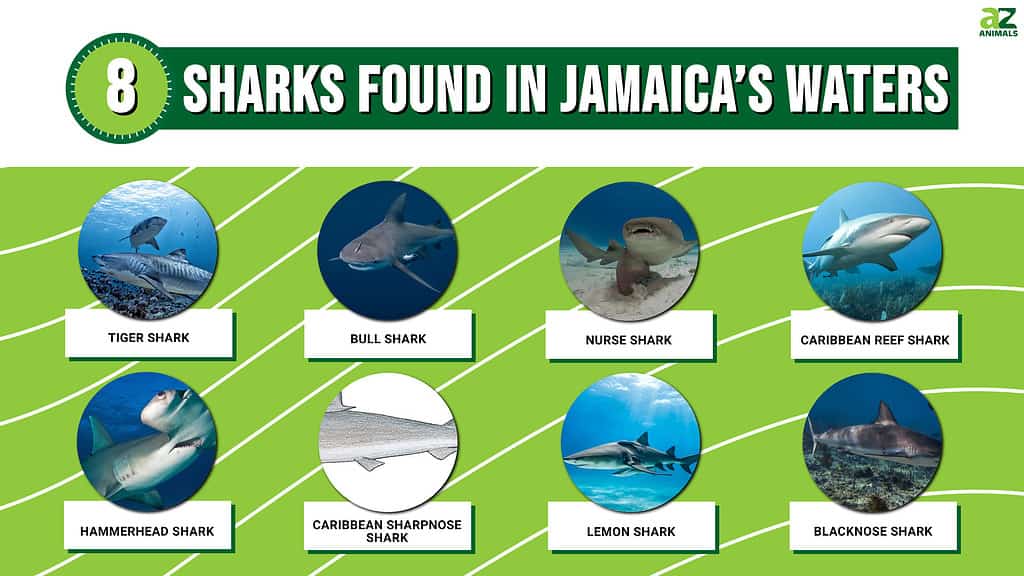
Here are 8 species of sharks found in Jamaica’s beautiful blue waters. So, when you visit, you can keep an eye out for these awesome species!
1. Tiger Shark (Galeocerdo cuvier)

The most distinguishing feature of the
tiger
shark is its tiger-like dark stripes.
©le bouil baptiste/Shutterstock.com
Tiger sharks are one of the most common sharks you will encounter in Jamaican waters. They are large predators that can grow over 13 feet long and weigh upwards of 1,400 pounds! They have blue to light-green skin on the upper half of their bodies and a white underside. These sharks get their name from the dark stripes around their bodies when they are young. However, these stripes will fade when the sharks grow older. The teeth of the tiger shark distinctively point sideways, curving inside, perfect for slicing through the toughest of prey, such as sea turtle shells.
The tiger shark is mostly found in warm temperate waters. They prefer shallow coastal waters where freshwater meets the ocean, as this is where much of their prey congregate. The diet of the tiger shark consists of almost anything they come across. Small fish, birds, dolphins, seals, and sea turtles are all common prey for this apex predator.
Tiger sharks can be found in the coastal waters of Jamaica, but they prefer deeper waters below 10 feet.
2. Bull Shark (Carcharhinus leucas)

Beware when you come across a bull shark in Jamaica, as they can be aggressive.
©Harry Collins Photography/Shutterstock.com
Bull sharks are another common species of shark that can be found in Jamaica. These sharks are known for their aggressive behavior and shark attacks. These sharks are large and stout and can grow between 7 and 11.5 feet in length. They can weigh anywhere between 200 and 500 lbs. They have short and blunt snouts and large dorsal fins. The coloration of the bull shark is grey with a white underside. And their teeth are large and triangular with serrated edges.
The bull shark is found around the world and lives in both freshwater and seawater. Their diet consists of fish, dolphins, sea turtles, rays, other sharks, and more. These carnivores are apex predators, so they are not generally preyed upon by other animals.
Bull sharks, unfortunately, can be found in Jamaican waters. They prefer shallow water, which means they have more interaction with humans. This closeness can lead to shark attacks due to the aggressive nature of bull sharks.
3. Nurse Shark (Ginglymostoma cirratum)
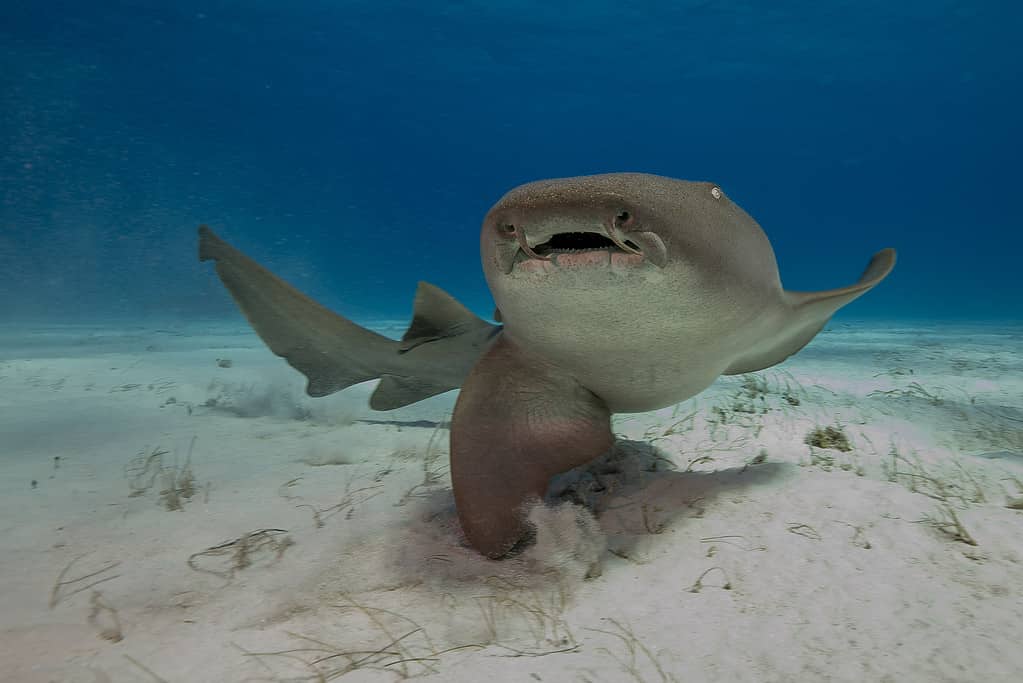
One of the most common sharks in Jamaica’s waters is nurse sharks.
Nurse sharks are a common sight in Jamaican waters. They are often found resting during the day on the ocean floor. These sharks can grow around 7.5 to 9 feet long and weigh between 150 and 300 pounds. They have tan to dark brown skin, which is mottled with darker black spots over their entire bodies when they are young. The mottling fades as they mature. Nurse sharks also have a pair of barbels extending from their snout, which help them to locate prey.
Nurse sharks hunt at night and mostly feed on crustaceans, small fish, stingrays, squid, and mollusks. Thankfully, nurse sharks do not see humans as food and will not attack unless provoked.
Nurse sharks can be found around the coasts of Jamaica and typically spend their time in and around shallow reefs and mangroves where there is plenty of prey. Montego Bay, Negril Reef, and Arches dive sites are all common spots to see these sharks.
4. Caribbean Reef Shark (Carcharhinus perezi)
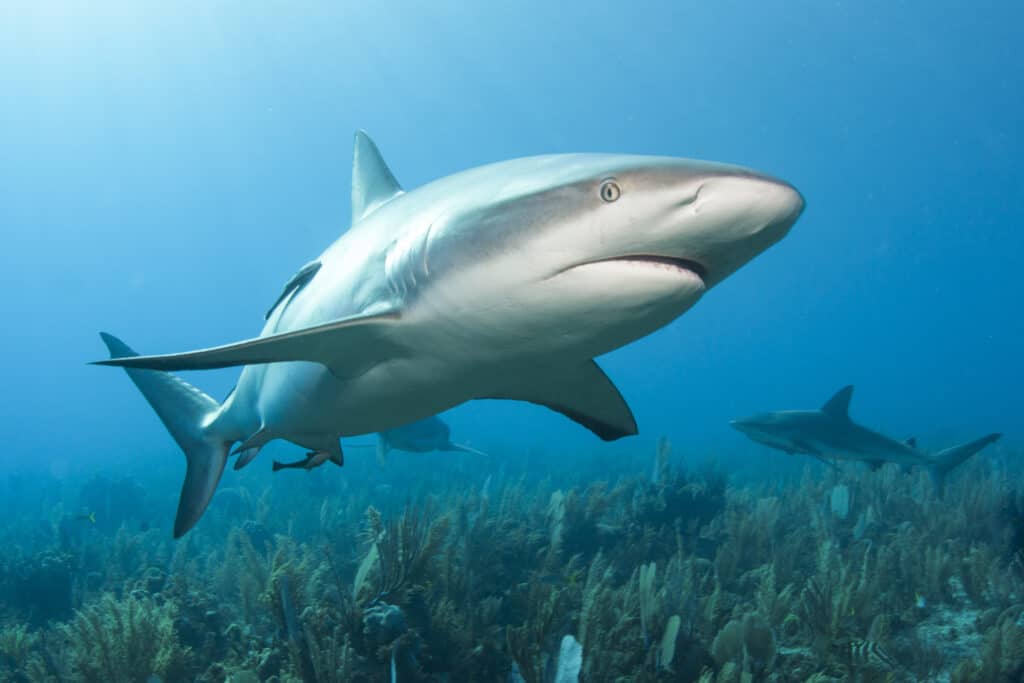
Found in shallow waters, Caribbean reef sharks are an apex predator in the reef system.
©Konstantin Novikov/Shutterstock.com
Caribbean reef sharks are found in shallow waters and are a common sight in Jamaica’s waters. These sharks generally grow between 6.5 and 8.2 feet long and weigh around 150 lbs. The Caribbean reef shark is heavy-bodied with a short, wide snout, and their eyes are large and round. The dorsal aspect of the shark is generally between gray-brown and dark gray in color, while the ventral side is either yellowish-white or white. There is also a subtle white stripe on the flanks of the shark.
As its name suggests, the Caribbean reef shark inhabits shallow waters on and around coral reefs. These sharks prefer warm waters and can be found in the western Atlantic Ocean, the Gulf of Mexico, and the Caribbean Sea. The Caribbean reef shark is an apex predator in the reef system, and its diet consists of reef-dwelling creatures such as barracuda, octopus, snapper, and eagle rays.
The Caribbean reef shark is very common around the reefs of Jamaica. Luckily, unlike the bull shark, these sharks are not very interested in humans and will only attack when food is involved.
5. Hammerhead Shark (family Sphyrnidae)
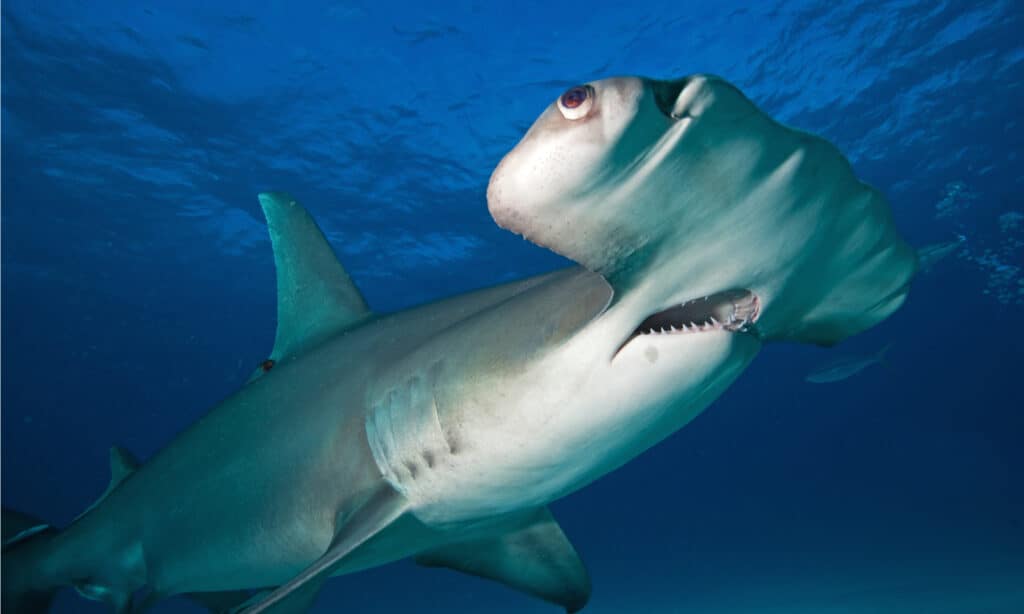
Two types of hammerhead sharks you can spot in Jamaica are: great hammerhead and scalloped hammerhead.
©Martin Prochazkacz/Shutterstock.com
You can spot hammerhead sharks in deeper waters near Jamaica. In particular, there are two different species of these sharks here: the great hammerhead shark (Sphyrna mokarran), and the scalloped hammerhead (Sphyrna lewini). The scalloped hammerhead shark is the more common of the two.
Hammerhead sharks have distinctive T-shaped heads with eyes on each end. They are grayish-brown on the upper half of their body with a lighter white underside. Hammerheads can grow up to 20 feet long and weigh up to 1,000 pounds.
Thanks to their uniquely shaped head, eye placement, and electroreception abilities, these sharks have great prey detection skills, which makes them excellent hunters. They feed on a range of marine life, including small fish, squid, crustaceans, and even other sharks.
Being a migratory animal, the best time to see hammerhead sharks in Jamaica is during the warmer summer months as they travel to tropical regions when the water gets cold. They are more commonly found in offshore waters and reefs, where there is plenty of food for them to hunt.
6. Caribbean Sharpnose Shark (Rhizoprionodon porosus)
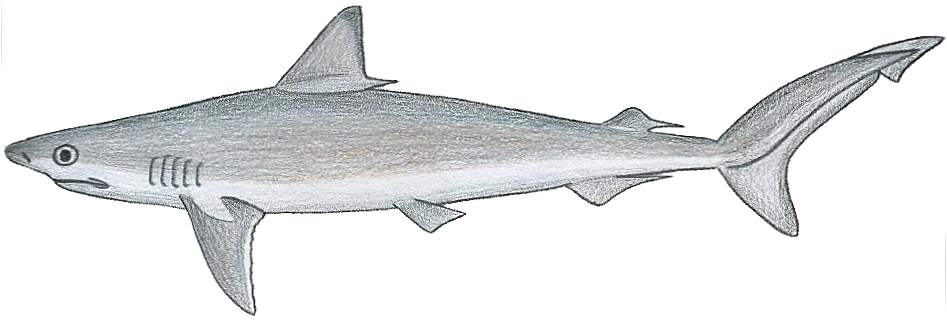
Caribbean sharpnose sharks are small, growing up to only 35 inches long.
Although not as common as nurse sharks and the Caribbean reef sharks, the Caribbean sharpnose shark can also be found in Jamaican coastal waters just below the surface. These sharks are small, with adult sharks growing up to a length between 31.5 and 35 inches and weighing around 7 lbs. They have elongated and slender bodies with long snouts. Their eyes are large, and their teeth are triangular-shaped. Furthermore, the dorsal side of this shark is brown or grayish-brown in color, and the ventral side is almost white.
The Caribbean sharpnose shark can be found in coastal, tropical areas and swims around in bays and estuaries. The shark’s diet includes small fish, marine snails, squid, and shrimp.
Because these sharks can be found in surfing areas and estuaries, they do come into contact with humans. However, because of their size, attacks are not usually serious or life-threatening.
7. Lemon Shark (Negaprion brevirostris)
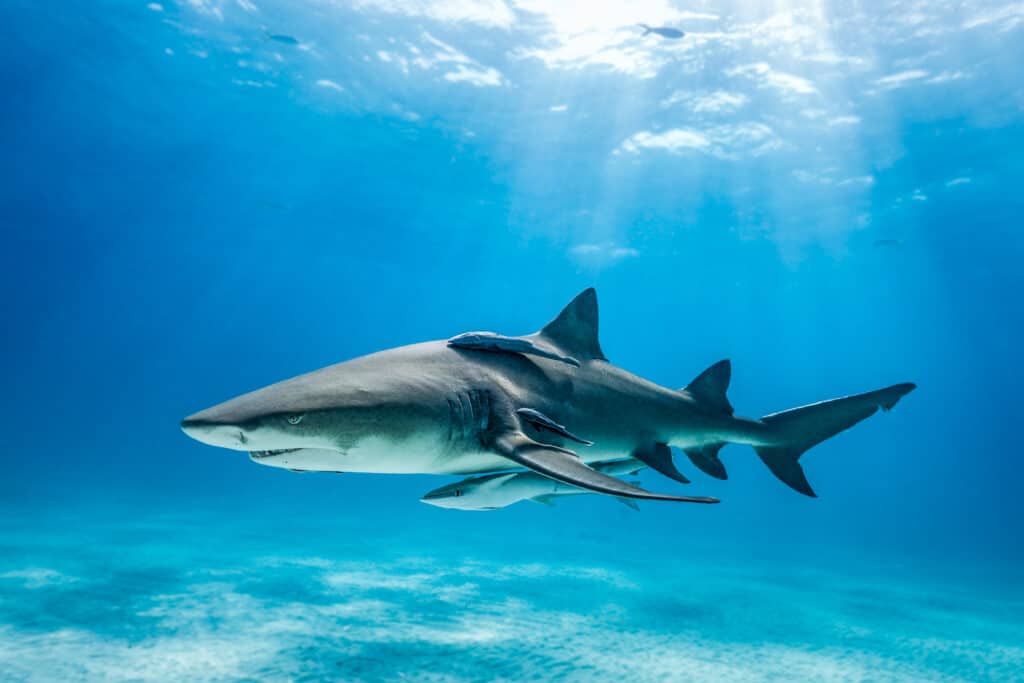
Named for their coloration, lemon sharks are slightly yellow.
©iStock.com/Michael Geyer
Lemon sharks are found in Jamaican coastal areas and may be seen while snorkeling. The name comes from their slight yellow coloration. This coloration helps these sharks to blend into the sandy floor, which acts as camouflage from predators and helps to catch prey. Lemon sharks will typically grow between 8 and 10 feet long and weigh around 200 lbs. The heads of these sharks are flat, and their snouts are short and broad.
Lemon sharks are only found in tropical waters and live in the same area as their prey. This means you can find these sharks in coral reefs, enclosed bays, and other locations. The prey of the lemon shark consists mostly of fish. However, they will also feed on crustaceans and other smaller sharks whenever they get the opportunity.
The lemon shark is found throughout the year in Jamaica, with higher concentrations during the summer. Luckily, these sharks do not pose a significant threat to humans.
8. Blacknose Shark (Carcharhinus acronotus)

As their name suggests, blacknose sharks have a distinctive black area around their nose.
©iStock.com/ Ryan Cake
The blacknose shark is a common species that is found in Jamaican waters. Younger sharks can be found in shallower waters near the coast, while older sharks are more likely to be found in deeper waters. They get their name from the distinctive black area around the tip of their snout. These sharks are slim with a long snout and can grow over 4 feet long and weigh around 22 pounds. They are greenish or yellowish-brown in color on their upper half and have a white underbelly.
The blacknose shark’s diet varies depending on what is available but will consist mostly of small fish such as anchovies, pinfish, spiny boxfish, as well as octopus and squid. Because of their smaller size and impressive speed, these sharks are also known to swoop in and steal the already-caught prey of larger sharks.
You can usually spot blacknose sharks in the shallower waters near the coast. They are not known to be aggressive towards humans. In fact, they are usually shy and will flee if humans get too close.
Where to Spot Sharks in Jamaica
Jamaica is not well-known for its shark sightings. However, most sharks spotted in this country are on the south or southeast sides of the island. Because most sharks prefer deeper waters, it may be hard to spot them while swimming or from ashore. But luckily, some areas can be good for shark sightings – this includes Montego Bay, the Kingston area, and Westmoreland. The shark tourism that the island offers may be the best and safest way to spot sharks.
Shark Attacks in Jamaica
Shark attacks are rare in Jamaica, but since 1837, there have been 12 unprovoked shark attacks. Most of these attacks were when people were swimming or surfing in shallow water. The most recent shark attack in Jamaican waters occurred on the 24th of June, 2022. A fisherman was working in the water when the shark attacked his arm. He called to his nearby workmates, who raced over in their boat and rammed the shark. This caused the man’s arm to be ripped from his body. Thankfully, the man was rushed to the hospital and survived.
Although most sharks are not typically aggressive towards humans, sometimes sharks may mistake people for a seal or prey. To avoid shark attacks, it is best to avoid swimming alone and avoid wearing jewelry or bright-colored clothes. It is also important to remember that even though a shark may be considered unlikely to attack, any wild animal can change their attitude toward humans at any point. Therefore, it is best to treat all sharks as hostile and give them as much room as possible to avoid provoking them.
Summary of Sharks Found in Jamaica’s Waters
| Shark | Scientific Name |
|---|---|
| Tiger Shark | Galeocerdo cuvier |
| Bull Shark | Carcharhinus leucas |
| Nurse Shark | Ginglymostoma cirratum |
| Caribbean Reef Shark | Carcharhinus perezi |
| Hammerhead Shark | Sphyrnidae |
| Caribbean Sharpnose Shark | Rhizoprionodon porosus |
| Lemon Shark | Negaprion brevirostris |
| Blacknose Shark | Carcharhinus acronotus |
The photo featured at the top of this post is © le bouil baptiste/Shutterstock.com
Thank you for reading! Have some feedback for us? Contact the AZ Animals editorial team.







